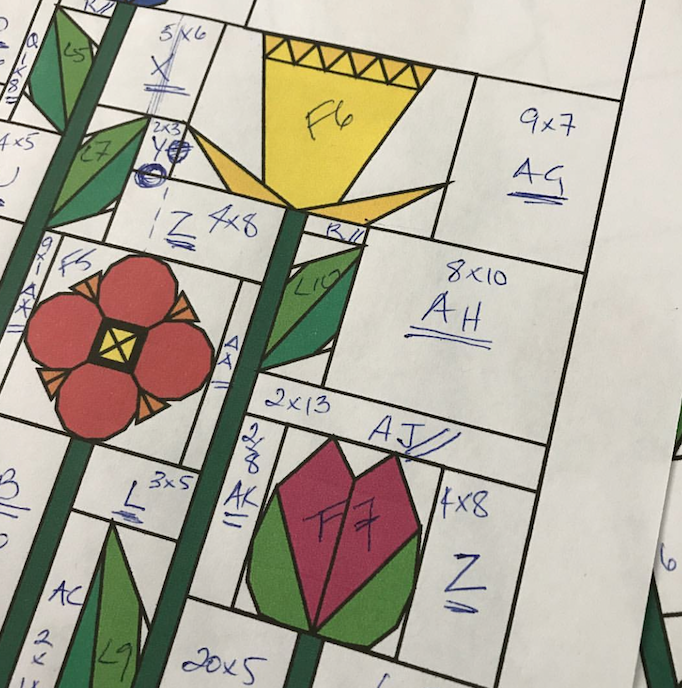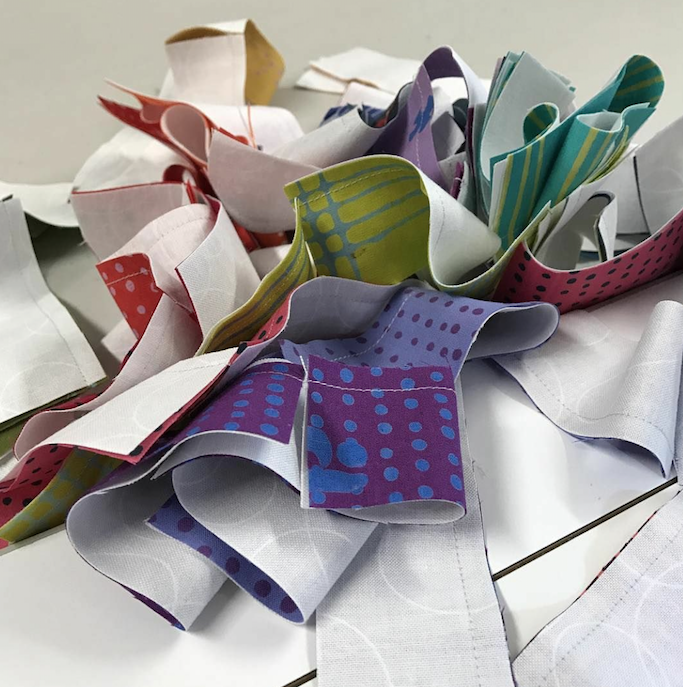Early in May I received an email from a reader who is quite frustrated with her recent purchases of patterns with costly cutting errors in them. She wrote to ask me to tackle this issue of pattern quality here on the blog. While I’m not a gun for hire for whatever bone someone wishes to pick with the quilting industry (!) I, of course, have a few thoughts on this, so here they are:
1. I can’t speak to what my friends and colleagues care about in their patterns writing endeavors, but I can tell you I have a mission statement for how I create mine. I don’t do this for fame and fortune (LOL!) I do it because I want people to have more fun making more stuff – I really consider pattern writing a SERVICE to both my industry and to our customers. MANY of my colleagues care just as much.

2. My reader asked “what the hell were the pattern testers doing?” My guess is they were trying their best. I have a core team* that reads and test-sews for me. Each of them have a specific area of skill that helps me – reading, drawings, flow, etc. Sadly though, ten people can look at a pattern and something still slips through. Whenever I’ve put a call out for new testers I never hear back from more than half the people who take the pattern draft. I will optimistically hope they had a “life happened” moment, and not presume they are just trying to get a free pattern out of me. And honestly, if they were, the joke’s on them as my first drafts can be pretty shaggy.

3A. My reader thought that testers were paid, which is seldom the case. I WISH I could pay my testers with cash; I send them patterns and occasionally other stuff, but it’s hardly equal to their work (I’m not given enough fabric to forward as compensation). Our industry is lucky to have a mostly kind fan base, and I’m beyond lucky that I have my team. They help because they want us/me to succeed. They think their effort is a worthy contribution for the betterment of the industry. That said, they are humans and therefore they goof up. As do I. I have a page where all errors are listed, and am sweatily relieved that most of my errors have been small, and not in the realm of the expensively large cut my reader was rightly upset about.
3B. Why can’t I pay them? Honestly, the profit margin at my end of a $12 pattern (that sells through a distributor to a shop) is in the neighborhood of $3.50. And sadly, it’s not enough for paying testers AND eating. Yes, I get all the profits from a PDF sold directly from my site, but it also takes about 100 hours to fully produce a pattern. And before you imagine my earnings are “bonus” in my family (like old-fashioned pin money) let me clarify for you that I have no husband, partner, other job, or trust fund. It’s just me.
3C. Why isn’t my income higher? The profits at the designer end just aren’t that high, so we rely on volume (and we have stores going out of business everywhere). While many of my customers respect what I do and happily pay for my design skills (and I adore you all for that), I’m sad to report that we still have a LOT of people who think that patterns should be free. These thieves copy our patterns far and wide to all their pals. A POX ON THEIR SEWING MACHINES.

4. My reader was upset that she didn’t get a reply when she wrote to a designer about an error. Again, all I can say is I write back as soon as I can, but within business hours – not at all hours of the night and weekends because really, this is quilting, not emergency medicine. I’m as responsive as I can be, and I care about fixing errors (see 1 above). And PLEASE check your junk/spam folder before presuming you didn’t get a response.
5A. My reader feels tempted to complain to her IG following to get the attention of the designer in question. To which I say, BE CAREFUL THERE. Yes, you get to say you’re not happy, but I think you should fear creating a social media pile-on of hate, because that’s what WILL happen. We have far too much hate in our world already, and the internet proves over and over again that people say the most horrible things from the anonymity of the keyboard. If you wouldn’t say it to their face, don’t type in on the internet. One way to handle this would be to become respected for writing thoughtful pattern reviews, giving equal weight to the things that worked out, not just the ones that don’t. Really, if you had a good time with a pattern, let the designer know (my most favorite emails!) and tell your friends with as much fervor as when you run into an error.
6. How do we ensure pattern quality? I wish I knew. We have a lot of new designers flooding into the industry, and while some of their ideas are brilliant, their skills at writing that brilliance down haven’t caught up yet. Some of them are willing to improve, others don’t seem to care – which mirrors every other industry on the planet. Yes, a global pattern review site would be lovely, but few people would be willing to pay to access it – and it would need to be paid for as it would be a huge undertaking to build and run. At the moment, word of mouth is what we have.
I hope fervently that my industry colleagues care as much as I do to make the best product possible for our customers, and I know many who do. When we all step up, and we can all rise together.
I, for one, think YOU’RE worth the effort.
* My core team are Monica, Ursula, the ‘Flakes, the SLO Creative Crew, and the Lucky 13 Ladies – thank you!


I enjoy your thoughtful and informative posts. I don’t understand how anyone could think patterns should be free! They should create just one!
They SHOULD! It would be an education!
I have seen a LOT of pattern horror stories lately, especially involving the “famous” fabric/pattern designers and their response has been tepid at best. There’s a “shortlist” in the back of my mind that I avoid patterns from entirely.
That is a sad thing! And that said, we all get to vote with our feet when it comes to where we put our $$
Great thoughts! As a new designer my biggest fear is having a huge mistake get missed. As a quilter I have experienced patterns that were frustrating, and try hard not to replicate that. I’m thankful for my testers who do a great job of helping me in that area.
I think we find out style, in part, by creating a list of things we hated in other patterns!
So well said. I test for several designers. I don’t do it for the money, I do it because it helps keep my mind sharp and at my age I need to work in the stash I have developed. Would live to join your crew next time you need a new team member. I think the theft aspect is one of the worst and most difficult things to deal with.
Sunshine and blessings to you for being a tester!
I find that your patterns are usually well written and easy to understand. I find your are always reliably accurate. Not so for some other designers.
Thank you Ursula!
Most people have no idea how much time goes into creating a pattern. We are often working on short deadlines. I’m greatful for those that generously give time freely to proofread and test for us. We are human and errors sometimes sneak by no matter how hard we work. Please reach out to designers and let them know you found an error.
I think the internet makes it look easy too… the prettiest pictures don’t tell the sometimes ugly slog.
Well said. I try daily to convince customers that they should purchase patterns so designers continue to design. Not purchasing a pattern is stealing from the designer’s ‘wage’.
Thank you for that! I often say “do you buy the veggies and pic for a thanksgiving dinner, and then steal the turkey?” The pattern is a vital centerpiece to the composition.
And I would add to this to make sure it is actually an error in the pattern and not a mistake on the maker’s end before you publicly comment! Great thoughts on this subject!
I work in the Publishing industry (not quilting/sewing related) so I know how much proofreading and instructions testing really costs. It’s not cheap – I pay an hourly rate of roughly 4 times the local minumum wage per hour to my suppliers (in case anyone wants a guide for how much to charge!). And however many times you get things checked, something is always missed. Always. And there always will be a customer who gets upset about this.
What I would say is, all checkers and testers are human. Humans make mistakes. We may use computerised tools, like spell checkers and calculators, but as with any tool, they have limitations and can’t prevent all errors.
I sometimes think of working up some of my patchwork and cross stitch designs into patterns and putting them up on Etsy/Craftsy/similar, but I wouldn’t be able to pay or compensate enough people suitably for pattern testing. So if I ever do, they will be undertested and therefore the first ones would be dodgy until I had some customer feedback. Even if I only test myself, I wouldn’t expect any profit from them for a long time once I’d factored in the cost of my own time.
I will readily admit that I think my later patterns are better than my earlier ones (I keep improving, I hope). he tough part about being really shaggy with your early stuff is that you don’t get too many chances to make a first impression. If you really make a mess of it, you are likely to destroy your customers’ trust, and that never comes back easily.
Thank you! This was an excellent read. Especially 5A, with which I couldn’t agree more.
An older quilter lady told me way back when I started quilting to always make a sample square! I will tell you I learnt the hard way ,cut out a whole quilt only to find that the block pieces could not go together ,so I now have an original quilt on my bed made up of those oieces made into a totally different block.????
Sounds like a very special quilt!
I woukdkove to be a tester for your patterns I have tons of fabric that I can’t let go of that would go to good use!
Next time I’m looking for testers I’ll post a request!
It is really nice to read your perspective on pattern design. It is refreshing to have you say what I feel about designing patterns. It takes a really skilled person to write a pattern for the many different skills/interests of the world of quilters. As a new designer I really panic when I find I made a mistake in my pattern and probably will still feel that way in the future. Thank you for sharing how you work with pattern testers – it gives me a good philosophy on how to ask for help!!
Oh, the panic on getting a “you have an error” email never leaves! I thinks it’s always going to upset you when you care 🙂
It’s frustrating, though, when every review is “fantastic” and the pattern is badly written or just plain incorrect. I find this less with quilt designers than with clothing and accessories. I also don’t understand the quilters who rave about designers who have corrections on Every. Single. Pattern. I’d much prefer to wait a month for the newest release and have it well checked and tested. Anyway, my 2 cents. Always appreciate your opinions!
I hear you. Sometimes I thing their review is about how the product looks, not how the pattern functions.
This was an excellent article! Sadly, there are designers out there who are not as concerned about testing a pattern, but I think they are few and far between and it isn’t long before people catch on the designer slowly fades into the dusk. I do document production for a large law firm. We have to convert odd documents into useable documents and the process requires proofreading. It never fails that we miss something, so I totally understand when mistakes creep in. However, most reputable designers, like you, have a page where errata is listed. I always check that first. Then I think through the pattern as I’m cutting – I hate the cutting process, so I do it in small steps, that way I normally will see something that doesn’t seem quite right and can check it…more often than not, it’s my error. The other thing I notice is that a lot of designer are designing on an extremely small deadline in order to show their quilts are vendor shows (like Quilt Market) – it’s so easy for mistakes to slip in (hence the errata page!). Finally, I love item 5A – that thought cannot be expressed enough. One thing I’ve learned working in a law firm – always write a draft, step away for a bit and then come back – do you really want to tell that lawyer he’s a short, fat, bald idiot? Deep breath, start again… Thanks for this article – I’m new to your site (found you on Facebook at Whimsicals Quilts page).
the quilt market deadlines are a HUGE challenge. I sew for fabric companies, and we often don’t have the fabric until just before market (I’ve had some fabric arrive with a week to spare) and their preference is to have brand new design with the brand new fabric. Sometimes I can work out the structure of a pattern before I see fabric, but sometimes the fabric drives the ideas, and doing that in a hurry is really hard. I often need to plaster my design wall with the fabrics and just stare at them for a couple of days – days that I don’t have in that cycle. The twice yearly peaks of panic for market are something I wish we could really smooth out!
Thanks for this great post – I found it via Facebook. I am slowly finding my way into quilt design and pattern writing. I’ve run a few classes at my lqs and this is another way of testing out a design/pattern. I hope the fact that there are so many budding pattern writers means that those who don’t produce clear accurate patterns will not be able to survive long in a competitive market. Your post has helped me to avoid the temptation to rush into launching a pattern without adequate testing and taking on board constructive feedback.
I think getting feedback is a hugely important (thought not always comfortable!) step in doing this work. Best of luck in producing your designs!
I find it really helps to read a pattern ALL THE WAY THROUGH before starting. Then as another reader suggests, make a sample block. If you should find a mistake, let the publisher or designer know so that the error can be corrected.
I think the read-through is critical 🙂
I bought a pattern and fabric kit at Hancock’s of Paducah a year ago and am now making the quilt. The designer does not indicate the size of the blocks, and my blocks are not coming out to an even number. She doesn’t answer PM’s on Facebook or emails. She does not accept new friend on FB , so I can’t post a question to her.
oh – how frustrating – so sorry!
The thought of designing a quilt and turning that into an actual written pattern, well, YIKES. That said, your patterns are some of the best I’ve used. Clear and concise, in my opinion. And makes paper piecing a logical process. Thank you!
thank YOU!